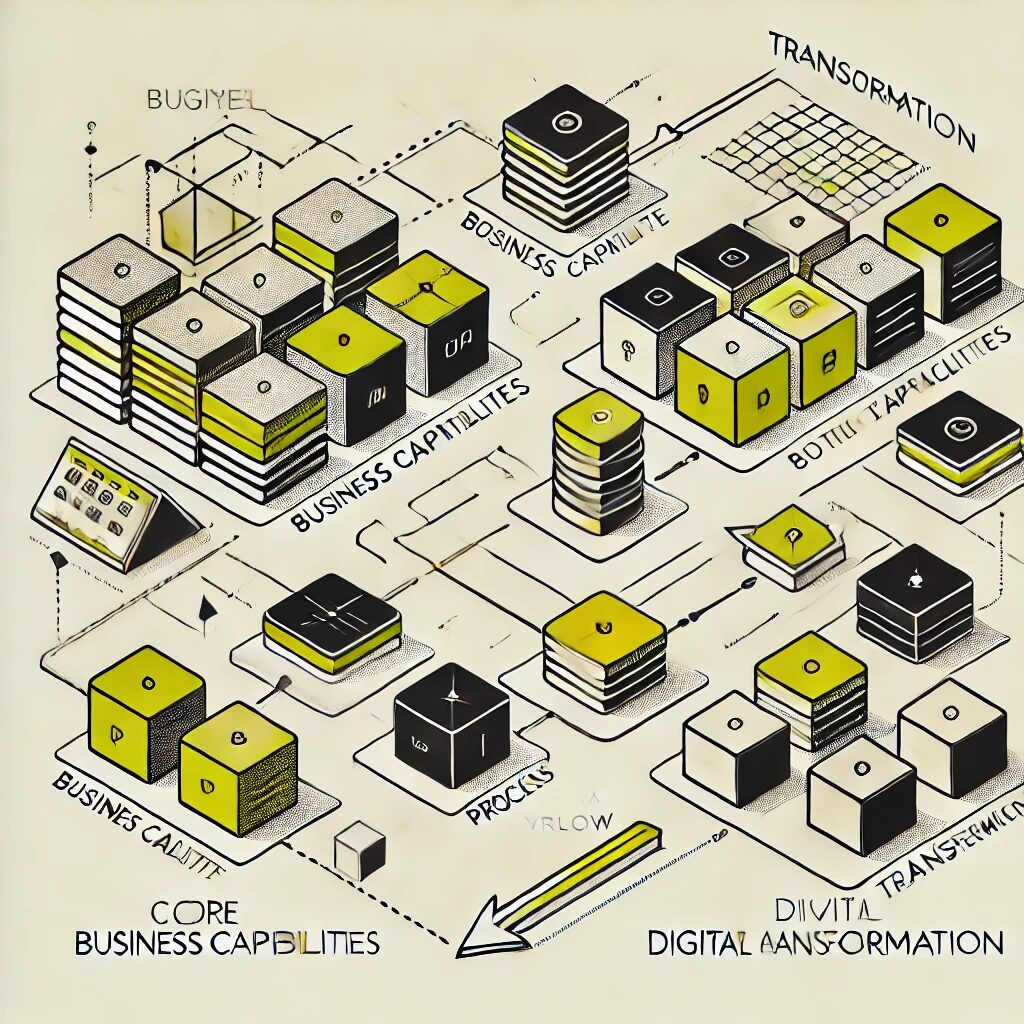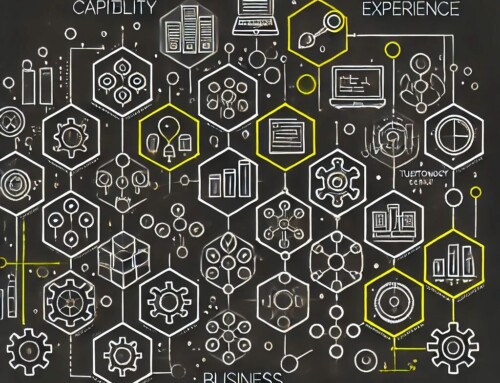
Accelerating Automotive Excellence Through Capability-Driven Architecture. Mapping the Road from Silos to Synergy: Optimizing Operations and IT in Automotive
The automotive industry faces unprecedented disruption as electrification, autonomous driving, connectivity, and shifting consumer expectations transform century-old business models. This evolution demands that traditional automotive manufacturers and suppliers reimagine their products and how their entire organizations operate. Leadership teams struggle to align operational capabilities with strategic priorities in this complex landscape while managing sprawling technology portfolios that often evolve through siloed decision-making.
Business Capability Maps provide the architectural foundation automotive companies need to navigate this transformation. By creating a structured view of what the organization does—independent of how it does it—capability maps enable leaders to align operations and technology investments with strategic priorities, eliminate redundancies, identify critical gaps, and create coherent roadmaps for digital transformation that deliver measurable business value.
1: The Automotive Optimization Challenge
Today’s automotive leaders face the dual challenge of optimizing legacy operations while rapidly building new capabilities for an electric, connected, and autonomous future. Business Capability Maps provide the foundation for meeting this challenge.
- Legacy Complexity: Most automotive organizations struggle with decades of accumulated operational variations and technical debt that obstruct agility and drain resources from strategic initiatives.
- Digital Transformation Imperative: The industry’s shift toward software-defined vehicles and service-based business models demands rapid development of digital capabilities while maintaining manufacturing excellence.
- Investment Alignment: Without a clear capability-based view, automotive companies risk misallocating critical resources across competing priorities from electrification to autonomous development.
- Operational Silos: Traditional departmental boundaries between engineering, manufacturing, supply chain, and customer operations create inefficiencies and hinder the integrated experience that modern automotive customers expect.
- Technology Proliferation: Years of tactical technology decisions have created complex, overlapping IT landscapes that are expensive to maintain and difficult to evolve to meet new business needs.
2: Business Capability Maps Defined
Business Capability Maps provide a stable, business-focused view of what an automotive organization does, separate from how it performs these functions through processes, organizational structures, or technologies.
- Architectural Foundation: Capability Maps serve as the primary business architecture view that connects strategic objectives to operational execution and technology enablement.
- Business Function Inventory: The map documents all the unique functions an automotive organization must perform to operate effectively, from vehicle design to manufacturing execution to mobility service delivery.
- Hierarchical Structure: Effective capability maps employ a hierarchical structure with domains (e.g., Product Development), capability groups (e.g., Electrification Engineering), and individual capabilities (e.g., Battery System Design).
- Stable Reference Model: Unlike processes or organizational structures that frequently change, capabilities remain relatively stable, providing a consistent reference point for transformation planning.
- Common Language: Capability maps create a shared vocabulary that bridges the communication gap between business and technology leaders in automotive organizations.
3: Operational Optimization Through Capability Analysis
Capability mapping enables automotive companies to identify operational redundancies, gaps, and improvement opportunities across the enterprise.
- Capability Ownership Clarity: Mapping reveals where multiple departments perform similar functions, creating opportunities to consolidate operations and establish clear accountability.
- Process Rationalization: Capability analysis identifies where different business units execute similar capabilities through divergent processes, enabling standardization and best practice sharing.
- Resource Allocation: Heat mapping capabilities by strategic importance versus current performance guides investment prioritization and resource allocation decisions.
- Value Stream Alignment: Connecting capabilities to end-to-end value streams reveals bottlenecks and coordination points that impact operational performance.
- Organizational Alignment: Capability maps provide the foundation for designing organizational structures that minimize silos and optimize cross-functional collaboration.
4: Technology Portfolio Optimization
Capability Maps provide the essential foundation for rationalizing complex automotive IT landscapes and aligning technology investments with business priorities.
- Application Portfolio Mapping: Connecting applications to the capabilities they support reveals redundant systems, capability gaps, and opportunities for consolidation.
- Technology Investment Alignment: Capability-based portfolio analysis ensures IT investments directly support the capabilities most critical to strategic objectives like electrification or autonomous development.
- Legacy Modernization: Heat mapping capability importance against supporting system health drives prioritization of legacy modernization efforts.
- Build vs. Buy Decisions: Capability analysis informs make/buy/partner decisions by clarifying which capabilities provide competitive differentiation versus those that can be standardized.
- Enterprise Architecture Governance: Capability maps establish the business context essential for effective technology governance and roadmap development.
5: Capability Assessment and Prioritization
Systematic capability assessment transforms static maps into dynamic tools for operational and technology optimization in automotive organizations.
- Maturity Assessment: Evaluating capability maturity across dimensions like process efficiency, automation, and performance measurement identifies specific improvement opportunities.
- Strategic Classification: Categorizing capabilities as differentiating, competitive, or foundational helps focus investments on areas with greatest strategic impact.
- Performance Gap Analysis: Measuring the gap between current and required capability performance levels drives prioritization of improvement initiatives.
- Industry Benchmarking: Comparing capability maturity against industry leaders and disruptive entrants identifies critical competitive gaps in areas like software development or battery technology.
- Transformation Impact Analysis: Assessing how major strategic shifts like electrification will impact capability requirements ensures proactive capability development.
DID YOU KNOW?
- According to McKinsey research, automotive companies with mature capability mapping practices achieve 22% higher returns on digital transformation investments compared to industry peers.
6: Optimizing Product Development Capabilities
Automotive product development demands specialized capability optimization to address the industry’s shift toward software-defined vehicles and electrification.
- Digital Engineering Acceleration: Capability mapping identifies opportunities to enhance simulation, virtual testing, and digital twin capabilities that reduce physical prototyping and accelerate development cycles.
- Software Development Excellence: Capability assessment reveals gaps in software engineering capabilities that are increasingly critical for vehicle differentiation and feature delivery.
- Electrification Specialization: Mapping electrification-specific capabilities—from battery management to thermal system design—ensures focused investment in these strategically critical areas.
- Platform Strategy Enablement: Capability analysis supports the development of modular product platforms that balance economies of scale with market differentiation.
- Supplier Integration: Capability mapping clarifies the optimal boundaries between internal capabilities and supplier contributions across the vehicle development lifecycle.
7: Manufacturing and Supply Chain Optimization
Capability mapping enables automotive manufacturers to enhance operational performance across production and supply networks while building resilience.
- Smart Factory Enablement: Capability assessment identifies opportunities to enhance manufacturing operations through advanced analytics, IoT implementation, and process automation.
- Supply Network Visibility: Mapping supply chain capabilities reveals opportunities to enhance end-to-end visibility, collaboration, and risk management across tiers of suppliers.
- Quality Management Integration: Capability analysis exposes gaps in quality capabilities across the value chain, enabling more proactive and integrated approaches to quality assurance.
- Operational Flexibility: Capability mapping helps manufacturers identify investments needed to enhance production flexibility in response to shifting market demands and electrification requirements.
- Sustainability Implementation: Capability assessment identifies gaps in circular economy capabilities from sustainable material sourcing through end-of-life vehicle processing.
8: Customer Experience Optimization
Capability mapping enables automotive companies to deliver more integrated, personalized customer experiences across physical and digital touchpoints.
- Omnichannel Experience: Capability assessment identifies gaps and redundancies in customer engagement capabilities across digital platforms, dealerships, and vehicle interfaces.
- Data-Driven Personalization: Mapping reveals opportunities to enhance customer data capabilities that enable personalized experiences across the ownership lifecycle.
- Connected Services Delivery: Capability analysis exposes operational and technical requirements for delivering and monetizing connected vehicle services.
- Lifecycle Engagement: Capability mapping helps optimize capabilities across the complete customer journey from research through purchase, ownership, and repurchase.
- Direct Sales Enablement: For organizations shifting toward direct sales models, capability mapping identifies new capabilities required to bypass traditional dealer networks.
9: IT and Data Architecture Alignment
Capability mapping provides the business context essential for optimizing enterprise information and technology architectures in automotive organizations.
- Data Architecture Alignment: Mapping information requirements by capability ensures data architecture supports critical business needs while minimizing redundancy and inconsistency.
- Integration Prioritization: Capability analysis identifies the most critical integration points between systems to enable end-to-end business processes and customer experiences.
- Cloud Migration Strategy: Capability-based assessment guides cloud migration decisions, prioritizing applications supporting strategic capabilities for modernization.
- Technical Debt Reduction: Mapping application portfolios to capabilities highlights areas where technical debt poses the greatest business risk, informing modernization priorities.
- Analytics Enablement: Capability mapping reveals opportunities to enhance analytical capabilities across the organization, from engineering simulation to supply chain optimization.
10: IT Investment Optimization
Capability maps transform IT investment planning from technology-centric to business-outcome focused, ensuring maximum return on technology spending.
- Investment Alignment: Capability-based portfolio planning ensures technology investments directly support the capabilities most critical to automotive strategic priorities.
- Project Prioritization: Scoring proposed projects based on capability impact provides an objective framework for investment decisions across competing priorities.
- Business Case Development: Capability mapping strengthens technology business cases by clearly articulating how investments enhance specific business functions.
- Value Realization: Connecting technology deployments to capability improvements enables more effective measurement of IT investment outcomes.
- Shadow IT Reduction: Comprehensive capability and application mapping reveals unauthorized technology deployments that create security risks and integration challenges.
DID YOU KNOW?
- A 2023 study by Gartner found that automotive manufacturers who used capability mapping to guide IT portfolio rationalization reduced their application portfolios by an average of 18%, resulting in annual savings of 12-15% in technology operating costs.
11: Digital Transformation Acceleration
Capability mapping provides the architectural foundation for more effective digital transformation in automotive organizations.
- Transformation Scope Definition: Capability analysis clearly defines the scope of digital initiatives, preventing scope creep and ensuring focus on high-value opportunities.
- Capability Gap Identification: Mapping reveals where new digital capabilities must be developed to support emerging business models around connectivity, autonomy, and mobility services.
- Legacy Transformation: Capability assessment identifies which legacy systems and processes require urgent modernization to enable digital business models.
- Change Impact Analysis: Capability mapping enables comprehensive assessment of how digital initiatives will impact operations, skills, and organizational structures.
- Ecosystem Integration: Capability analysis clarifies which functions should be developed internally versus accessed through partners in the automotive digital ecosystem.
12: Mergers and Acquisitions Optimization
Capability mapping significantly enhances M&A outcomes in the rapidly consolidating automotive sector by providing a structured approach to integration planning.
- Due Diligence Enhancement: Capability assessment during due diligence provides deeper insight into target organizations’ strengths, weaknesses, and strategic fit.
- Integration Planning: Capability mapping creates a common framework for identifying redundancies, complementary strengths, and integration priorities.
- Synergy Identification: Mapping capability maturity across merging organizations reveals specific opportunities for cost reduction and capability enhancement.
- Cultural Alignment: Capability-based discussions provide a neutral, objective framework for aligning organizations with different histories and approaches.
- Technology Rationalization: Capability mapping accelerates application portfolio rationalization, a critical and often costly aspect of automotive M&A integration.
13: Governance and Operating Model Optimization
Capability maps provide the foundation for more effective governance and operating model design in automotive organizations.
- Decision Rights Clarity: Capability mapping establishes clear ownership and decision rights for each business function, reducing conflicts and accelerating decisions.
- Performance Measurement: Capability-based metrics enable more holistic performance management across organizational boundaries.
- Investment Governance: Capability maps support more effective governance of both business and technology investments through a common framework.
- Organizational Design: Capability analysis informs organizational structure decisions that better align with strategic priorities and cross-functional requirements.
- Centers of Excellence: Capability mapping identifies where specialized centers of excellence can accelerate the development of critical capabilities like software engineering or data analytics.
14: Capability Implementation Roadmaps
Effective capability maps translate strategic intent into actionable implementation roadmaps for both operational and technology transformation.
- Transformation Sequencing: Capability analysis informs logical sequencing of initiatives based on dependencies, strategic importance, and organizational readiness.
- Incremental Delivery: Capability-based roadmaps enable incremental value delivery through phased enhancement of specific business functions.
- Resource Optimization: Implementation roadmaps based on capability prioritization ensure efficient use of limited transformation resources.
- Risk Management: Capability mapping reveals dependencies and potential bottlenecks that could impact transformation timelines.
- Stakeholder Alignment: Capability-based roadmaps create shared understanding of transformation priorities and timelines across business and technology stakeholders.
15: Future-Proofing Automotive Organizations
Beyond current optimization, capability mapping helps automotive organizations prepare for ongoing industry disruption and business model evolution.
- Emerging Capability Identification: Forward-looking mapping identifies new capabilities required for future business models around autonomous mobility, battery lifecycle management, and connected services.
- Competitive Monitoring: Capability-based competitive analysis tracks how traditional competitors and new entrants are building capabilities that could disrupt the industry.
- Scenario Planning: Capability mapping supports scenario analysis to assess how different industry futures would impact required business functions and technology requirements.
- Ecosystem Positioning: Capability assessment helps organizations determine their optimal position in evolving automotive ecosystems and value chains.
- Agility Enhancement: Mature capability management increases organizational adaptability by providing a stable reference model for responding to market changes.
DID YOU KNOW?
- Automotive organizations that employ capability-based planning are 2.5 times more likely to successfully implement major transformations like electrification or connected vehicle platforms, according to recent research by Forrester.
Takeaway
Business Capability Maps have emerged as an essential architectural tool for automotive organizations navigating the industry’s unprecedented transformation. By providing a stable, business-focused view of the enterprise independent of organizational structures, processes, or technologies, capability maps enable leaders to optimize both operations and IT landscapes. From identifying operational redundancies to rationalizing complex application portfolios, capability mapping creates the foundation for more strategic decision-making, effective resource allocation, and successful transformation. As the automotive industry continues evolving toward software-defined vehicles, new mobility models, and sustainable operations, capability-driven architecture will remain a critical enabler of operational excellence and strategic agility.
Next Steps
- Assess your current state: Evaluate existing business architecture artifacts and determine whether your organization comprehensively understands its capabilities and how they map to strategic priorities, operational processes, and technology systems.
- Start with a strategic domain: Begin capability mapping in a high-priority area facing significant transformation, such as product development for electrification or customer experience across physical and digital channels.
- Connect to strategic planning: Ensure capability mapping is integrated with strategic planning processes so that capability enhancements directly support enterprise objectives.
- Establish governance: Define clear ownership for capability management and integrate capability-based thinking into investment governance for both business and technology initiatives.
- Build cross-functional engagement: Develop a stakeholder engagement plan to build understanding and buy-in for capability-based planning across business and technology leadership.
- Focus on value realization: Identify specific operational pain points or technology optimization opportunities where capability mapping can deliver tangible near-term value while building foundation for longer-term transformation.



